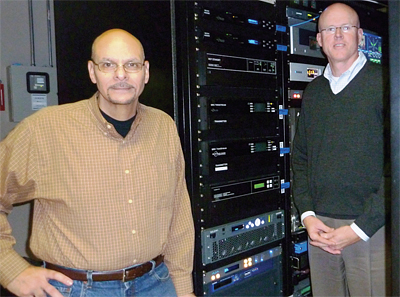WJZY Pushes Delivery Envelope With Harris Selenio

Robert Castillo (L), and Shawn Harris, WJZY vice president and general manager
CHARLOTTE, N.C.: WJZY is the CW affiliate for the Charlotte/Belmont DMA, and operates in high definition on Channel 46. We also provide additional programming streams, including two mobile channels. The ATSC revolution has provided television broadcasters with the ability to generate new revenue streams by transmitting multiple television, data, and mobile services to viewers. However, capitalizing on this compelling mobile business opportunity hinges on the ability to maximize the 19.39 Mbps transmission channel.
HAD TO MAINTAIN VIDEO QUALITY
As Mobile DTV is critical to growing the digital broadcasting business model, we knew that we had to provide service in this area and needed a multiplexing/encoding system that could accommodate a minimum of two mobile services while providing very high quality signals. We found the ideal solution at the 2011 NAB Show—the Harris Selenio media convergence platform. As the station has an enterprise-wide IP network, the Selenio also met key concerns in allowing us to merge IP networking, MPEG-2 and H.264 encoding, and baseband video and audio processing on a single platform.
Shawn Harris, WJZY's vice president/ general manager, and I asked Harris to expand the Selenio's channel capacity to meet our multicasting needs, and the Selenio engineering team worked closely with us in conducting complex tests and simulations at our station until this expanded channel capacity was a reality.
Selenio takes the HD/SD video and audio for our 46.1, 46.2 and 46.3 channels and multiplexes these signals into a single ATSC data stream. Separately, it encodes and multiplexes video and audio for the two mobile services (Mobile-1, which is a replay of our 46.1 CW programming, and Mobile-2, which carries our 46.3 Country Network channel) into a single ATSC M/H data stream, and then muxes the whole package into a single ATSC transport stream. We went live with the Selenio system in December and have been very pleased with its performance.
ENOUGH BITS FOR EVERYONE
Statistical multiplexing was an extremely critical concern for us, and it's one of the biggest selling features of this box. Selenio's statistical multiplexing cleverly analyzes bandwidth demands and manages allocation to each of the encoded signals in the multiplex. This results in a very efficient ATSC transport stream. We also make full use of the system's surround sound and loudness control audio capabilities.
The first real test of the system came on Jan. 16, 2012, when we aired a live NCAA men's basketball game on 46.1 in high-definition (Georgia Tech vs. the University of Maryland). While the bandwidth-hungry 1080i HD sports signal could have crowded out the other signals in the stream, Selenio managed the entire payload efficiently and with impressive picture quality.
We consider the Selenio system to be a key player in the complete Harris system that we use to provide both terrestrial and Mobile DTV broadcasting services. It has already proven to be very cost-effective and operationally efficient. Selenio is an ideal IP networking and encoding system for broadcasters building their futures on DTV multicasting and mobile DTV services.
Robert Castillo is director of engineering at WJZY television. He may be contacted at RCastillo@wjzy.com.
For additional information, contact Harris at 800-231-9673 or visit www.broadcast.harris.com.
The professional video industry's #1 source for news, trends and product and tech information. Sign up below.
